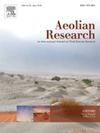Arid Shrubland: A growing dust source?
IF 3.4
3区 地球科学
Q2 GEOGRAPHY, PHYSICAL
引用次数: 0
Abstract
The west coast of South Africa is an arid region that has been shown to be emissive, but its dust sources have never been studied in detail. In this study, we present a dataset of the Moderate Resolution Imaging Spectroradiometer (MODIS)-detected dust source points in this region from 2000 to 2021 and the surface characteristics of these points. The results elucidate that most dust source points are located on Succulent Karoo shrublands, mining areas, or bare areas. Furthermore, the data show a significant increase in dust source points, which could mainly be attributed to shrublands becoming more emissive as a response to a prolonged drought from 2017 onwards. The Normalised Difference Vegetation Index (NDVI), Modified Soil Adjusted Vegetation Index (MSAVI), and albedo-based roughness indication (ωns) of the study area confirmed a decrease in vegetation during this five-year drought. Understanding such tipping points for dust emissions as a result of drought and anthropogenic land use is relevant to understanding the future dust load.
干旱灌木丛:一个不断增长的尘埃来源?
南非西海岸是一个干旱地区,已被证明是有排放的,但其粉尘来源从未被详细研究过。在本研究中,我们提供了2000 - 2021年该地区MODIS中分辨率成像光谱仪(MODIS)探测的尘埃点数据集和这些尘埃点的地表特征。结果表明,卡鲁多肉灌丛地、矿区和裸地是主要的粉尘源。此外,数据显示,粉尘源点显著增加,这主要是由于自2017年以来,由于长期干旱,灌木地的排放量增加。标准化植被差异指数(NDVI)、改良土壤调整植被指数(MSAVI)和基于反照率的粗糙度指数(ωns)均证实了5年干旱期间研究区植被的减少。了解干旱和人为土地利用导致的粉尘排放的临界点与了解未来的粉尘负荷有关。
本文章由计算机程序翻译,如有差异,请以英文原文为准。
求助全文
约1分钟内获得全文
求助全文
来源期刊

Aeolian Research
GEOGRAPHY, PHYSICAL-
CiteScore
7.10
自引率
6.10%
发文量
43
审稿时长
>12 weeks
期刊介绍:
The scope of Aeolian Research includes the following topics:
• Fundamental Aeolian processes, including sand and dust entrainment, transport and deposition of sediment
• Modeling and field studies of Aeolian processes
• Instrumentation/measurement in the field and lab
• Practical applications including environmental impacts and erosion control
• Aeolian landforms, geomorphology and paleoenvironments
• Dust-atmosphere/cloud interactions.
 求助内容:
求助内容: 应助结果提醒方式:
应助结果提醒方式:


